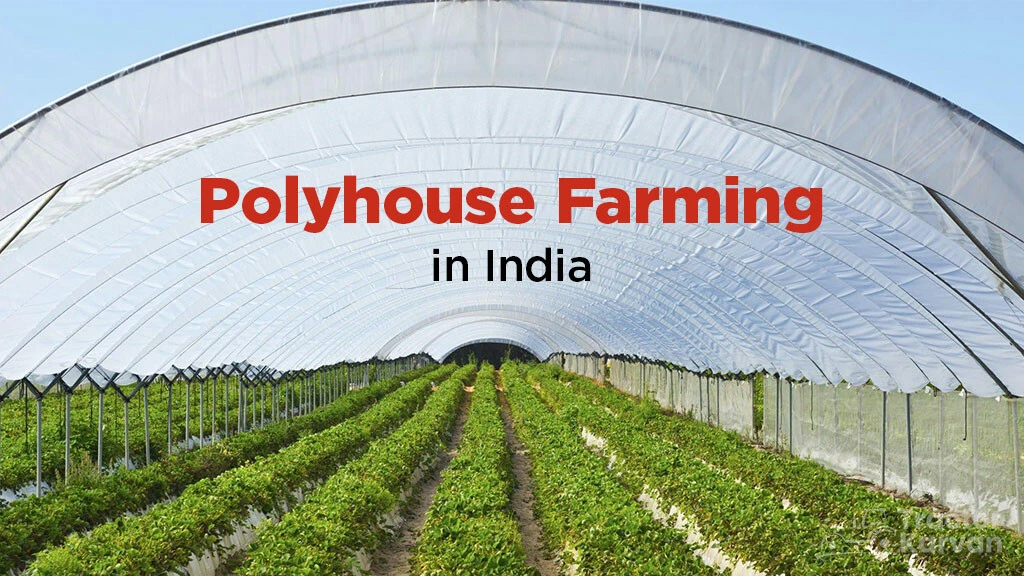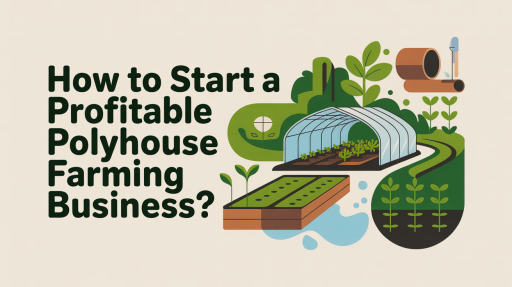The traditional agricultural practices that depend on seasonal rain or open-field farming are no longer the only options. With increasing pressures from population growth, urbanization, and climate change, there is an urgent need for resource-efficient and resilient farming systems. Polyhouse farming in India has emerged as an evolutionary solution, offering a modern approach to agricultural entrepreneurship.
Polyhouse farming is a way to increase productivity and produce better-quality products while reducing risks from pests, disease, and bad weather. It is not only an agricultural venture but a modern agribusiness that opens doors to high-value markets, both domestically and abroad.
This article examines how to set up a profitable polyhouse farm, including the market potential of the sector, its demand growth, crop suitability, and the step-by-step process for farming.
Understanding Polyhouse Farming
A polyhouse is an enclosed structure that looks like a greenhouse, covered in transparent or semi-transparent polyethylene sheets. These sheets allow light to pass through while protecting the plants from environmental stress. The structure creates a semi-controlled environment, allowing temperature, humidity, and ventilation to be controlled according to the crop’s needs.
Key benefits include:
- Year-Round Cultivation: Unlike open-field agriculture, which is heavily influenced by the unpredictability of the climate, polyhouse farming is a year-round option. Multi-cycle production of crops that are usually seasonal increases profitability.
- Pest and Disease Control: This method reduces the need for pesticides, as crops are partly protected from pests and disease, making them more attractive to export markets and health-conscious consumers.
- Resource Efficiency: Polyhouses are also known for their efficient use of water and fertilizers. Using drip irrigation systems and fertigation, farmers can precisely deliver water and nutrients to the roots of plants. This not only increases production but also reduces costs per unit.
Related Article: Step-by-Step Process to Set Up a Polyhouse Farming Unit
Market Outlook for Polyhouse Farming
Polyhouse farming and protected agriculture have grown in popularity around the world as governments and agribusinesses look for solutions to the food security challenge. Globally, the greenhouse and polyhouse market was valued at USD 32 billion and is expected to double to USD 65 billion by 2032, driven by a CAGR of 9-10%. This growth is fueled by a growing consumer demand for high-quality vegetables, fruits, flowers, and herbs.
India has seen a dramatic expansion in polyhouse farming. According to the Ministry of Agriculture, more than 50,000 hectares of land have been brought under protected cultivation. This number is expected to increase dramatically over the next few years, with Maharashtra and Karnataka leading in the adoption of this model.
There are also many opportunities in the domestic market. With urban consumers showing a growing preference for exotic vegetables like zucchini, lettuce, broccoli, and colored capsicum, the demand for controlled-environment produce has grown steadily. This rising trend highlights how Polyhouse Farming in India can meet the growing need for premium, pesticide-free crops in metropolitan cities.

Suitable Crops for Polyhouse Farming
Not all plants are suitable for polyhouses. It is more profitable to cultivate high-value crops that require special care and fetch premium prices.
- Floriculture: The floriculture industry is a great place to start for exports. Gerberas and carnations are popular options, as they are in high demand internationally and require constant temperature and humidity.
- Vegetables: Polyhouses are ideal for vegetables like colored capsicums, cucumbers, and tomatoes. Due to their superior quality, longer shelf life, and reduced pesticide use, these vegetables command higher prices.
- Fruits: Fruits like strawberries and melons can also be highly profitable, particularly when marketed to niche markets such as premium supermarkets or food chains.
How to Start a Polyhouse Farming Business
Planning and executing a polyhouse farm venture involves several key steps:
- Site Selection: Choose a suitable site. You should choose land that is well-drained, leveled, and located in an area with enough sunlight.
Easy access to water and electricity is essential. Proximity to markets, logistics hubs, and cold storage facilities is important to reduce transportation costs. - After selecting the site, you should carefully choose the polyhouse design. Depending on the climate and crop, you can either use naturally ventilated polyhouses or equip them with fan-pad systems. Builders usually make the roof from UV-stabilized polyethylene sheets, and they construct the structures using galvanized pipes.Ventilation systems, fogging systems, and insect-proof nets are crucial components.
- Irrigation and Fertigation: An efficient irrigation system is non-negotiable. The combination of drip irrigation and fertigation results in uniform growth, higher yields, and a more precise delivery of nutrients.
- Crop Selection and Cultivation: The selection of crops must be based on market demand, potential profitability, and adaptability. To maximize production, it is important to use proper cultivation techniques, such as planting, spacing, pruning, and training.
- Pest Management and Monitoring: While polyhouse farming reduces pest risk, entrepreneurs should still adopt integrated pest management (IPM) practices like sticky traps and biocontrol agents. Continuous monitoring of temperature, humidity, and plant health is vital to ensure the quality of your produce.
Growth Drivers and Opportunities
Polyhouse farming is a great opportunity for entrepreneurs due to several factors:
- The growing demand for pesticide-free, high-quality export produce.
- The willingness of customers to pay more for fresh and safe food.
- The expansion of export markets for exotic vegetables and floriculture.
- Government support through subsidies, skill-development programs, and technical assistance.
- Technological advancements like IoT, climate monitoring, and automation make farming more sustainable and efficient.
Startups should also look at opportunities beyond farming. Growing businesses include those related to polyhouse construction, input supply (such as drip systems and polyethylene sheets), post-harvest logistics, and marketing of exotic produce. The sector is not just about cultivation but also about building a value chain around it.
The Manufacturing Process of Polyhouse Structures
The establishment of a polyhouse structure is similar to industrial manufacturing. The first step is to finalize the design. Next, you purchase the raw materials.
Fabrication involves bending, welding, and assembling the pipes to form a stable frame. Workers carefully fix the polyethylene sheets to cover the structure.
The installation of irrigation and fertilization systems follows. Finally, they subject the structure to quality tests to ensure it can handle the weather and maintain the required microclimate.
.
Challenges and Considerations
While the opportunities are great, entrepreneurs should also be aware of the challenges:
- High Expertise Required: Polyhouse farming requires expertise in managing controlled environments. Negligence can lead to crop losses.
- Disease Spread: In closed conditions, diseases can spread quickly, requiring timely prevention.
- Market Dynamics: Prices of exotic vegetables and flowers may vary. Establishing reliable buyer networks and exploring export contracts can help stabilize revenue.
- Post-Harvest Management: Perishable crops require cold storage and efficient transportation systems.
Find all of our books here.
The Future of Polyhouse Agriculture
Polyhouse farming has a bright future. Experts expect the sector to grow by a factor of ten in the next decade, driven by the growing demand for organic, safe products, technological advancements, and export-oriented demands
India’s protected-cultivation market could triple its size by 2030, creating millions of new business opportunities. The integration of smart farming tools, such as artificial intelligence and IoT-based weather monitoring, will further improve efficiency and profitability.
Find the Best Idea for Yourself With our Startup Selector Tool
NPCS’s Role in Supporting Entrepreneurs
Expert guidance is crucial for entrepreneurs interested in polyhouse farming. Niir Project Consultancy Services (NPCS) is a reliable partner in this regard. NPCS provides detailed techno-economic feasibility reports for new projects in diverse industries.
The reports contain vital information such as manufacturing processes, raw material requirements, plant layouts, and financials. NPCS has decades of experience in helping entrepreneurs assess the feasibility of establishing farming and new industries, reducing risk, and increasing the chances of success.
For more information, check out this Related video.
Conclusion
Polyhouse farming is more than just a modern agricultural technique; it is a lucrative business opportunity aligned with global trends in sustainability, efficiency, and high-quality production. Entrepreneurs can take advantage of the growing demand for this product, favorable government policies, and the chance to serve both domestic and international markets.
By choosing the right crops, building durable infrastructure, using smart cultivation techniques, and leveraging consultancy support, agripreneurs can create a sustainable and scalable polyhouse farm. Polyhouse farming will play a key role in the transformation of the agricultural sector and the growth of entrepreneurs.
Frequently Asked Questions(FAQ)
Q1. What is Polyhouse Farming in India?
Polyhouse Farming in India involves growing crops in controlled structures that regulate temperature, humidity, and light, providing optimal conditions year-round, regardless of the weather.
Q2. How does Polyhouse Farming benefit Indian farmers?
It boosts crop yield and quality while reducing pests and diseases. It also conserves water and reduces production costs, making it a profitable farming method.
Q3. Which crops are suitable for Polyhouse Farming in India?
Polyhouse farming is ideal for high-value crops like colored capsicum, tomatoes, cucumbers, strawberries, and flowers such as gerberas and carnations.
Q4. Is Polyhouse Farming in India profitable?
Yes, it can be highly profitable, especially for high-demand crops. The controlled environment boosts productivity and allows for multi-cycle production, yielding premium prices.
Q5. What are the key challenges of Polyhouse Farming in India?
Challenges include the high initial investment, need for specialized knowledge, and managing crop health in a controlled environment. Establishing reliable buyers is also important.







